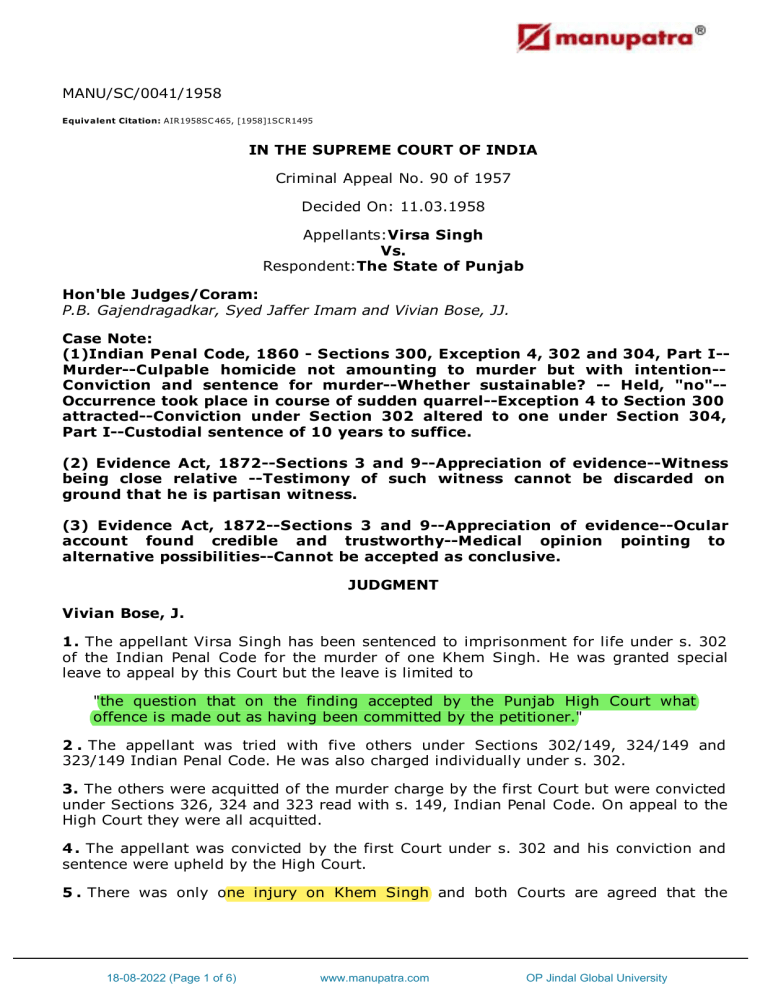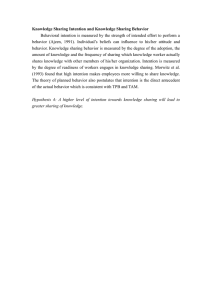
MANU/SC/0041/1958 Equivalent Citation: AIR1958SC 465, [1958]1SC R1495 IN THE SUPREME COURT OF INDIA Criminal Appeal No. 90 of 1957 Decided On: 11.03.1958 Appellants:Virsa Singh Vs. Respondent:The State of Punjab Hon'ble Judges/Coram: P.B. Gajendragadkar, Syed Jaffer Imam and Vivian Bose, JJ. Case Note: (1)Indian Penal Code, 1860 - Sections 300, Exception 4, 302 and 304, Part I-Murder--Culpable homicide not amounting to murder but with intention-Conviction and sentence for murder--Whether sustainable? -- Held, "no"-Occurrence took place in course of sudden quarrel--Exception 4 to Section 300 attracted--Conviction under Section 302 altered to one under Section 304, Part I--Custodial sentence of 10 years to suffice. (2) Evidence Act, 1872--Sections 3 and 9--Appreciation of evidence--Witness being close relative --Testimony of such witness cannot be discarded on ground that he is partisan witness. (3) Evidence Act, 1872--Sections 3 and 9--Appreciation of evidence--Ocular account found credible and trustworthy--Medical opinion pointing to alternative possibilities--Cannot be accepted as conclusive. JUDGMENT Vivian Bose, J. 1. The appellant Virsa Singh has been sentenced to imprisonment for life under s. 302 of the Indian Penal Code for the murder of one Khem Singh. He was granted special leave to appeal by this Court but the leave is limited to "the question that on the finding accepted by the Punjab High Court what offence is made out as having been committed by the petitioner." 2 . The appellant was tried with five others under Sections 302/149, 324/149 and 323/149 Indian Penal Code. He was also charged individually under s. 302. 3. The others were acquitted of the murder charge by the first Court but were convicted under Sections 326, 324 and 323 read with s. 149, Indian Penal Code. On appeal to the High Court they were all acquitted. 4 . The appellant was convicted by the first Court under s. 302 and his conviction and sentence were upheld by the High Court. 5 . There was only one injury on Khem Singh and both Courts are agreed that the 18-08-2022 (Page 1 of 6) www.manupatra.com OP Jindal Global University appellant caused it. It was caused as the result of a spear thrust and the doctor who examined Khem Singh, while he was still alive, said that it was. 6. "a punctured wound 2 x 1/2" transverse in direction on the left side of the abdominal wall in the lower part of the iliac region just above the inguinal canal. 7. He also said that "Three coils of intestines were coming out of the wound." 8. The incident occurred about 8 p.m. on July 13, 1955. Khem Singh died about 5 p.m. the following day. 9. The doctor who conducted the post-mortem described the injury as 10. "an oblique incised stitched wound 2 1/2" on the lower part of left side of belly, 1 3/4" above the left inguinal ligament. The injury was through the whole thickness of the abdominal wall. Peritonitis was present and there was digested food in that cavity. Flakes of pus were sticking round the small intestines and there were six cuts...... at various places, and digested food was flowing out from three cuts." 11. The doctor said that the injury was sufficient to cause death in the ordinary course of nature. 12. The learned Sessions Judge found that the appellant was 21 or 22 years old and side "When the common object of the assembly seems to have been to cause grievous hurts only, I do not suppose Virsa Singh actually had the intention to cause the death of Khem Singh, but by a rash and silly act he gave a rather forceful blow, which ultimately caused his death. Peritonitis also supervened and that hastened the death of Khem Singh. But for that Khem Singh may perhaps not have died or may have lived a little longer." 13. Basing on those facts, he said that the case fell under s. 300, 3rdly and so he convicted under s. 302, Indian Penal Code. 14. The learned High Court Judges considered that "the whole affair was sudden and occurred on a chance meeting." But they accepted the finding that the appellant inflicted the injury on Khem Singh and accepted the medical testimony that the blow was a fatal one. 15. It was argued with much circumlocution that the facts set out above do not disclose an offence of murder because the prosecution has not proved that there was an intention to inflict a bodily injury that was sufficient to cause death in the ordinary course of nature. Section 300, 3rdly was quoted : "If it is done with the intention of causing bodily injury to any person and the bodily injury intended to be inflicted is sufficient in the ordinary course of nature to cause death." 16. It was said that the intention that the section requires must be related, not only to the bodily injury inflicted, but also to the clause, "and the bodily injury intended to be inflicted is sufficient in the ordinary course of nature to cause death. 18-08-2022 (Page 2 of 6) www.manupatra.com OP Jindal Global University 17. This is a favourite argument in this kind of case but is fallacious. If there is an intention to inflict an injury that is sufficient to cause death in the ordinary course of nature, then the intention is to kill and in that event, the "thirdly" would be unnecessary because the act would fall under the first part of the section, namely "If the act by which the death is caused is done with the intention of causing death." 18. In our opinion, the two clauses are disjunctive and separate. The first is subjective to the offender : "If it is done with the intention of causing bodily injury to any person." 19. It must, of course, first be found that bodily injury was caused and the nature of the injury must be established, that is to say, whether the injury is on the leg or the arm or the stomach, how deep it penetrated, whether any vital organs were cut and so forth. These are purely objective facts and leave no room for inference or deduction : to that extent the enquiry is objective; but when it comes to the question of intention, that is subjective to the offender and it must be proved that he had an intention to cause the bodily injury that is found to be present. 20. Once that is found, the enquiry shifts to the next clause "and the bodily injury intended to be inflicted is sufficient in the ordinary course of nature to cause death." 21. The first part of this is descriptive of the earlier part of the section, namely, the infliction of bodily injury with the intention to inflict it, that is to say, if the circumstances justify an inference that a man's intention was only to inflict a blow on the lower part of the leg, or some lesser blow, and it can be shown that the blow landed in the region of the heart by accident, then, though an injury to the heart is shown to be present, the intention to inflict an injury in that region, or of that nature, is not proved. In that case, the first part of the clause does not come into play. But once it is proved that there was an intention to inflict the injury that is found to be present, then the earlier part of the clause we are now examining "and the bodily injury intended to be inflicted" is merely descriptive. All it means is that it is not enough to prove that the injury found to be present is sufficient to cause death in the ordinary course of nature; it must in addition be shown that the injury is of the kind that falls within the earlier clause, namely, that the injury found to be present was the injury that was intended to be inflicted. Whether it was sufficient to cause death in the ordinary course of nature is a matter of inference or deduction from the proved facts about the nature of the injury and has nothing to do with the question of intention. In considering whether the intention was to inflict the injury found to have been inflicted, the enquiry necessarily proceeds on broad lines as, for example, whether there was an intention to strike at a vital or a dangerous spot, and whether with sufficient force to cause the kind of injury found to have been inflicted. It is, of course, not necessary to enquire into every last detail as, for instance, whether the prisoner intended to have the bowels fall out, or whether he intended to penetrate the liver or the kidneys or the heart. Otherwise, a man who has no knowledge of anatomy could never be convicted, for, if he does not know that there is a heart or a kidney or bowels, he cannot be said to have 18-08-2022 (Page 3 of 6) www.manupatra.com OP Jindal Global University intended to injure them. Of course, that is not the kind of enquiry. It is broad based and simple and based on commonsense : the kind of enquiry that "twelve good men and true" could readily appreciate and understand. To put it shortly, the prosecution must prove the following facts before it can bring a case under s. 300, "3rdly"; Test for 3rdly 22. First, it must establish, quite objectively, that a bodily injury is present. 2 3 . Secondly, the nature of the injury must be proved; These are purely objective investigations. 24. Thirdly, it must be proved that there was an intention to inflict that particular bodily injury, that is to say, that it was not accidental or unintentional, or that some other kind of injury was intended. 25. Once these three elements are proved to be present, the enquiry proceeds further and. 26. Fourthly, it must be proved that the injury of the type just described made up of the three elements set out above is sufficient to cause death in the ordinary course of nature. This part of the enquiry is purely objective and inferential and has nothing to do with the intention of the offender. 27. Once these four elements are established by the prosecution (and, of course, the burden is on the prosecution throughout) the offence is murder under s. 300, 3rdly. It does not matter that there was no intention to cause death. It does not matter that there was no intention even to cause an injury of a kind that is sufficient to cause death in the ordinary course of nature (not that there is any real distinction between the two). It does not even matter that there is no knowledge that an act of that kind will be likely to cause death. Once the intention to cause the bodily injury actually found to be proved, the rest of the enquiry is purely objective and the only question is whether, as a matter of purely objective inference, the injury is sufficient in the ordinary course of nature to cause death. No one has a licence to run around inflicting injuries that are sufficient to cause death in the ordinary course of nature and claim that they are not guilty of murder. If they inflict injuries of that kind, they must face the consequences; and they can only escape if it can be shown, or reasonably deduced that the injury was accidental or otherwise unintentional. 28. We were referred to a decision of Lord Goddard in R. v. Steane (1947) 1 All E.R. 813, 816 where the learned Chief Justice says that where a particular intent must be laid and charged, that particular intent must be proved. Of course it must, and of course it must be proved by the prosecution. The only question here is, what is the extent and nature of the intent that s. 300, 3rdly requires, and how is it to be proved? 29. The learned counsel for the appellant next relied on a presage where the learned Chief Justice says that : "if, on the totality of the evidence, there is room for more than one view as to the intent of the prisoner, the jury should be directed that it is for the prosecution to prove the intent to the jury's satisfaction, and if, on a review of the whole evidence, they either think that the intent did not exist or they are 18-08-2022 (Page 4 of 6) www.manupatra.com OP Jindal Global University left in doubt as to the intent, the prisoner is entitled to be acquitted." 30. We agree that that is also the law in India. But so is this. We quote a few sentences earlier from the same learned judgment : "No doubt, if the prosecution prove an act the natural consequences of which would be a certain result and no evidence or explanation is given, then a jury may, on a proper direction, find that the prisoner is guilty of doing the act with the intent alleged." 31. That is exactly the position here. No evidence or explanation is given about why the appellant thrust a spear into the abdomen of the deceased with such force that it penetrated the bowels and three coils of the intestines came out of the wound and that digested food oozed out from cuts in three places. In the absence of evidence, or reasonable explanation, that the prisoner did not intend to stab in the stomach with a degree of force sufficient to penetrate that far into the body, or to indicate that his act was a regrettable accident and that he intended otherwise, it would be perverse to conclude that he did not intend to inflict the injury that he did. Once that intent is established (and no other conclusion is reasonably possible in this case, and in any case it is a question of fact), the rest is a matter for objective determination from the medical and other evidence about the nature and seriousness of the injury. 3 2 . The learned counsel for the appellant referred us to Emperor v. Sardarkhan Jaridkhan (1917) I.L.R. 41 Bom 23, 29 where Beaman J., says that "Where death is caused by a single blow, it is always much more difficult to be absolutely certain what degree of bodily injury the offender intended." With due respect to the learned Judge he has linked up the intent required with the seriousness of the injury, and that, as we have shown, is not what the section requires. The two matters are quite separate and distinct, though the evidence about them may sometimes overlap. The question is not whether the prisoner intended to inflict a serious injury or a trivial one but whether he intended to inflict the injury that is proved to be present. If he can show that he did not, or if the totality of the circumstances justify such an inference, then, of course, the intents that the section requires is not proved. But if there is nothing beyond the injury and the fact that the appellant inflicted it, the only possible inference is that he intended to inflict it. Whether he knew of its seriousness, or intended serious consequences, is neither here nor there. The question, so far as the intention is concerned, is not whether he intended to kill, or to inflict an injury of a particular degree of seriousness, but whether he intended to inflict the injury in the question; and once the existence of the injury is proved the intention to cause it will be presumed unless the evidence or the circumstances warrant an opposite conclusion. But whether the intention is there or not is one of fact and not one of law. Whether the wound is serious or otherwise, and if serious, how serious, is a totally separate and distinct question and has nothing to do with the question whether the prisoner intended to inflict the injury in question. 33. It is true that in a given case the enquiry may be linked up with the seriousness of the injury. For example, if it can be proved, or if the totality of the circumstances justify an inference, that the prisoner only intended a superficial; scratch and that by accident this victim stumbled and fell on the sword or spear that was used, then of course the offence is not murder. But that is not because the prisoner did not intend the injury that 18-08-2022 (Page 5 of 6) www.manupatra.com OP Jindal Global University he intended to inflict to be as serious as it turned out to be but because he did not intend to inflict the injury in question at all. His intention in such a case would be to inflict a totally different injury. The difference is not one of law but one of fact; and whether the conclusion should be one way or the other is a matter of proof, where necessary, by calling in aid all reasonable inferences of fact in the absence of direct testimony. It is not one for guess-work and fanciful conjecture. 34. The appeal is dismissed. 35. Appeal dismissed. © Manupatra Information Solutions Pvt. Ltd. 18-08-2022 (Page 6 of 6) www.manupatra.com OP Jindal Global University



